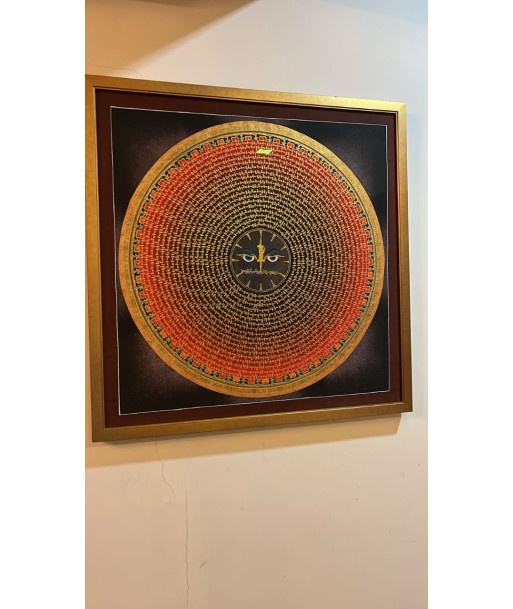- -50%
- New






Buddha—also known as the "Eyes of Buddha" or "Buddha Eyes".
The prominent eyes symbolize the omniscience of the Buddha—his ability to see all.
The dot or third eye between the eyes represents spiritual awakening or divine insight.
The squiggly symbol where a nose would be is actually the Nepali number 1, symbolizing unity and the path to enlightenment.
Surrounding the Buddha Eyes are mantras or Buddhist sutras meticulously inscribed in a spiral or mandala format.
The most common mantra used in such designs is:
"Om Mani Padme Hum"
This is the mantra of Avalokiteshvara, the Bodhisattva of Compassion.
Each syllable in the mantra purifies one of the six realms of existence.
 Security policy
Security policy
(edit with the Customer Reassurance module)
 Delivery policy
Delivery policy
(edit with the Customer Reassurance module)
 Return policy
Return policy
(edit with the Customer Reassurance module)
This is a Tibetan Buddhist Thangka painting featuring a mandala with concentric circles of sacred text, centered around the wisdom eyes of the Buddha—also known as the "Eyes of Buddha" or "Buddha Eyes".
The prominent eyes symbolize the omniscience of the Buddha—his ability to see all.
The dot or third eye between the eyes represents spiritual awakening or divine insight.
The squiggly symbol where a nose would be is actually the Nepali number 1, symbolizing unity and the path to enlightenment.
Surrounding the Buddha Eyes are mantras or Buddhist sutras meticulously inscribed in a spiral or mandala format.
The most common mantra used in such designs is:
"Om Mani Padme Hum"
This is the mantra of Avalokiteshvara, the Bodhisattva of Compassion.
Each syllable in the mantra purifies one of the six realms of existence.
The red and gold colors used in the mandala radiate out from the center, symbolizing spiritual energy and divine light.
The golden outer ring often contains protective symbols and blessings.
The mandala design symbolizes the universe in its ideal form, serving as a meditative aid.
It reflects balance, harmony, and the cyclical nature of existence.
This painting follows the Thangka tradition, a form of sacred Tibetan Buddhist art used for meditation, teaching, and devotional purposes.
Thangkas are typically created on cotton or silk, and often framed in brocade.
This type of Thangka is not just a visual artwork—it serves as a spiritual tool:
Used in meditation to focus the mind.
Acts as a prayer aid, with every syllable in the mantra offering merit to the viewer or reciter.
Often used in monasteries, shrines, or personal altars